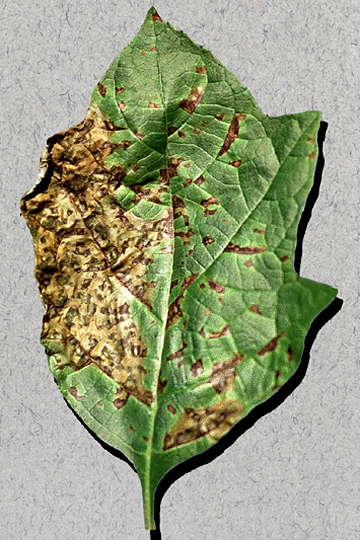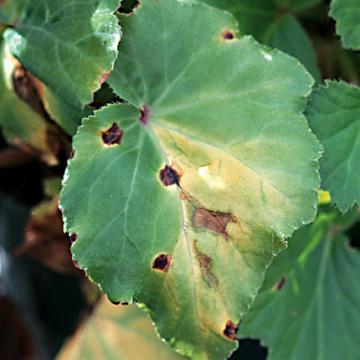DISEASE: Bacterial fasciation (Leafy gall)
HOST: Begonia
Leafy gall on stem.

Bacterial fasciation (Leafy gall) | Begonia
DISEASE: Bacterial fasciation (Leafy gall)
HOST: Begonia (Begonia sp.)
PATHOGEN: Rhodococcus fascians
SOURCE: M. Geesteranus, J. van der Wolf
DISEASE: Bacterial leaf spot (Blight)
HOST: Begonia
Initial symptoms appear as small, blisterlike lesions. As lesions age, they enlarge, producing broad patches of necrotic leaf tissue.

Bacterial leaf spot (Blight) | Begonia
DISEASE: Bacterial leaf spot (Blight)
HOST: Begonia (Begonia sp.)
PATHOGEN: Xanthomonas axonopodis pv. begoniae
PATHOGEN SYNONYM: Xanthomonas campestris pv. begoniae
SOURCE: APS
DISEASE: Bacterial leaf spot (Blight)
HOST: Begonia
Advanced stage of disease with dark, large necrotic areas on leaves and interveinal chlorosis.

Bacterial leaf spot (Blight) | Begonia
DISEASE: Bacterial leaf spot (Blight)
HOST: Begonia (Begonia sp.)
PATHOGEN: Xanthomonas axonopodis pv. begoniae
PATHOGEN SYNONYM: Xanthomonas campestris pv. begoniae
SOURCE: APS
DISEASE: Bacterial leaf spot
HOST: Hydrangea (Oak-leaf)
Leaf with individual brown necrotic lesions and coalesced lesions that formed large necrotic areas. The disease is caused by an unclassified xanthomonad.

Bacterial leaf spot | Hydrangea (Oak-leaf)
DISEASE: Bacterial leaf spot
HOST: Hydrangea (Oak-leaf) (Hydrangea quercifolia)
PATHOGEN: Xanthomonas campestris
SOURCE: W. Uddin, W. Sinclair
DISEASE: Olive knot
HOST: Olive
Multiple infections of young stems. The bacterium invades vascular tissues during certain times of the year and may be isolated from branches that appear healthy.

Olive knot | Olive
DISEASE: Olive knot
HOST: Olive (Olea europaea)
PATHOGEN: Pseudomonas savastanoi pv. savastanoi
SOURCE: M. Schroth
DISEASE: Olive knot
HOST: Olive
Tree with knots/galls on branches along with twig dieback, which is associated with knots. Fusarium and Diplodia spp. infect through knots and are thought to be main reason for dieback.

Olive knot | Olive
DISEASE: Olive knot
HOST: Olive (Olea europaea)
PATHOGEN: Pseudomonas savastanoi pv. savastanoi
SOURCE: M. Schroth









